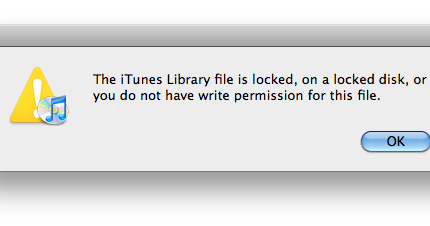Joe Sarsero writes in with an issue about disabling and re-enabling iCloud Photo Library in macOS. His wife turned iCloud Photo Library off with her 250GB set of photos and videos on a Mac with about 100GB of storage remaining on the drive. She then re-enabled it. She had full-resolution images turned on, so she didn’t lose any media in the process. (As to why, he didn’t say, but I did the same thing recently!)
However, Joe writes:
An error message appeared stating that photos in iCloud could not be downloaded to the Mac because there was not enough disk space. She would need to enable the Optimize Mac Storage setting in order to use iCloud Photo Library again on the Mac. I don’t understand what is happening. Full-resolution images are already on Mac.

Press the Apple and the options keys when you restart iPhoto, then select to rebuild the library database from the automatic back-up. IPhoto Won't Recognize Faces/Places. If you ever find that iPhoto is failing to recognize faces or places that you tell it, or that it has gotten correct in the past, you can re-sort the photos with each option. POSSIBLE ISSUE — Or, in the second situation, when you launch your iPhoto application, and a message comes up saying that it can't find your iPhoto library file, or in the window, you don't see the name of your library file listed, then this tells you that iPhoto is having a problem finding your entire photo collection. In this case, you will need to give iPhotos a little help in finding it.
iCloud and macOS are very, very bad at what should be a rudimentary sync operation. Apple must be using techniques that let it compare whether a photo in Photos for iOS or macOS already exists in the synced set at iCloud and on each connected device.
And yet, when I tested disabling and re-enabling iCloud sync, as Joe’s wife did, I was told I didn’t have enough storage at iCloud, even though I had nearly 90GB free and my library is about 115GB. That library was already stored in iCloud in identical form.
Instead of first comparing photos in iCloud with those on my system, I wasn’t able to proceed without upgrading my storage and then later downgrading it. (Apple lacks automatic pro-rated refunds, and even though it says you can email to obtain such a refund, I received no response to my email.)
There’s some sense in this: Apple doesn’t want you to start an operation that will fail. But it could also predict whether it would work or not.
Joe’s wife experienced the reverse: I’m guessing she has a 500GB iCloud subscription, required to store a 250GB library, and thus had enough “room” to upload a full new set, if Photos decided it needed to. That prevented her from seeing the error I did.
However, lacking enough free storage on the Mac to download that same amount of data, the download error displayed. There’s not much you can do about, because you can’t force iCloud to “believe” all the images are already synced.
I had assumed, as with most sync systems, Apple computes a kind of mathematical shorthand or signature that lets it compare two media files without uploading or download the entire file. If so, it should be a matter of minutes to scan and compare even tens of thousands of items. I have to conclude Apple doesn’t do that.
Unable To Write To Library Iphoto Library Error Machine
I can think of a few scenarios that might help Joe and spouse:
Move enough other files off the boot drive temporarily to an external drive to free up the space iCloud demands.
Switch to optimize, and hope that Photos doesn’t actually delete any or many full-resolution images. It should sync one at a time, and thus not flush full-resolution files unless it runs very low on space, which won’t occur. After the sync, turn back on the full-resolution option.
Copy the library to an external drive with sufficient free storage and set it as the primary Photos library, then enable iCloud Photo Library, and, after syncing, copy it back to the main drive and point to it as the main library—and hope that Photos retains the sync status.
Sadly, in each of these options, I fear that Apple will download all images afresh instead of just confirming that they’re synced. In my upload situation that I note above, my system seemingly re-uploaded 115GB of data, even though it was all identical and the final outcome resulted in no changes.
I have a uncapped gigabit internet, and was able to let the process take many hours. Joe notes, “We have poor bandwidth speed and data caps,” which makes the problem even worse.
I wish I had a better advice. If you can take the computer to a friendly person or location with very high-speed internet and no overage charges, that may be your best bet.
Unable To Write To Library Iphoto Library Error Mac Os
Ask Mac 911
We’ve compiled a list of the most commonly asked questions we get, and the answers to them: read our super FAQ to see if you’re covered. If not, we’re always looking for new problems to solve! Email yours to mac911@macworld.com including screen captures as appropriate. Mac 911 cannot reply to email with troubleshooting advice nor can we publish answers to every question.
Note: When you purchase something after clicking links in our articles, we may earn a small commission. Read ouraffiliate link policyfor more details.
- Related: